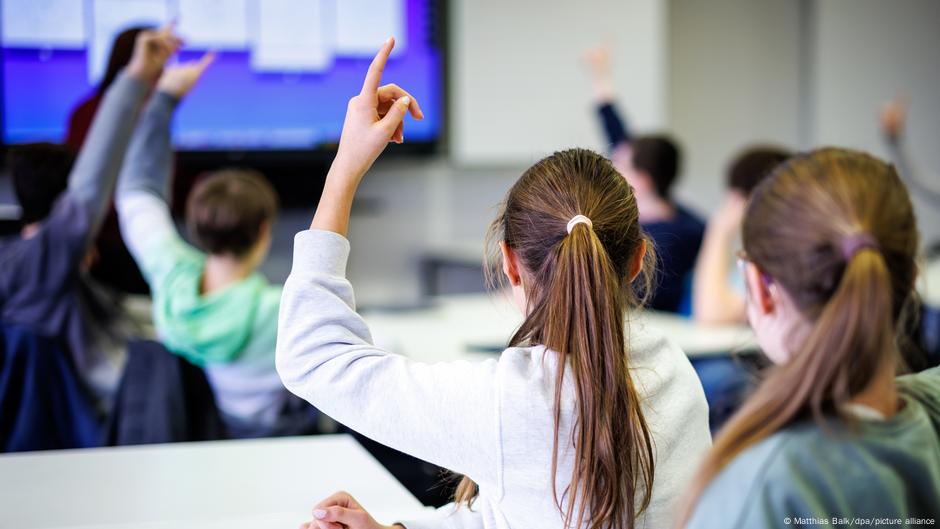That Jeff Grant signs off his emails with “science on!” says something about his commitment to the subject he teaches to Illinois high schoolers. Lately, that dedication has meant teaching a topic that makes some educators uncomfortable: the science of .
As an avid reader of scientific journals and books, and someone who spends time outdoors, he has a clear understanding of how rising temperatures are impacting the planet.
“It’s been something that for the last decade or so I’ve personally seen the effects of,” he said, citing changes to the aquatic, forest and prairie ecosystems he grew up with. As a result, he has started to “bake” into his classes.
Yale University research suggests his approach would be widely welcomed. Three-quarters of adults in the US say they want schools to teach the causes, consequences and potential solutions to global warming.
“Today’s students are tomorrow’s consumers, workers, and voters, and they’re going to be faced with a series of challenges due to the disruptions caused by ,” said Glenn Branch, deputy director of the non-profit National Center for Science Education (NCSE). And to deal with the challenges, he adds they’ll need “at least the basic understanding of climate change and its impacts and solutions.”
What students learn depends on where they live
The NCSE is one of several bodies working to ensure students across the country are given . But the decentralized nature of the US education system means curricula decisions are made at the level of the local school district. And with more than 13,000 of them across the nation, that equates to huge variation.
Teachers in some states can look to what are known as the Next Generation Science Standards for guidelines on teaching climate change. But they are not obligatory and don’t, Grant says, go far enough.
”Not every state has that as part of their curriculum,” he said, adding that even if they do, they don’t offer lesson plans. “It’s up to the teachers or the school districts to develop those things or find things to help them with that presentation to kids.”
And that is a problem, given that many educators never learned about climate change themselves. They are faced with huge volumes of potential resources to draw from, as well as competing interests from powerful groups trying to take their own agendas into classrooms.
Fossil fuel companies in the classroom
Branch says there have been “systematic attempts to provide teachers with misinformation about climate change in the hopes they will relate it to their students,” with material coming from “very strongly ideologically motivated” think tanks, such as the Heartland Institute, as well as from the fossil fuel industry itself.
Groups such as the Oklahoma Energy Resources Board (OERB), which is a privatized state agency, are active in a number of states across the US. And always with an educational arm. “That material is less blatant,” Branch said. “But it can still have a distorting influence.”
In the case of the OERB, the material includes a series of illustrated books that see protagonist “Petro Pete” praise human dependence on . The agency also provides workshops and curricula that give insights into the oil and gas industry. Educators who sign up are rewarded with professional development credits, stipends and class field trips.
Melissa Lau, who teaches science in her native Oklahoma, says such offerings strike a chord with teachers who don’t know enough about to teach it.
“That’s very appealing in many ways. If a teacher is like, ‘this seems legit…’ I mean, there’s not anything wrong with the science. It just gives the impression of ‘look how good the fossil fuel industry is.’ It minimizes the impact.”
OERB did not respond to a DW request for further information.
Making climate relatable to students and teachers
Lau says getting climate change into the classroom in Oklahoma is further complicated by the fact that — which is responsible for almost 12% of global emissions — and fossil fuels, are among the state’s major industries.
“A lot of times it is, ‘you know, my dad is just trying to make a living, we’re trying to feed our family, keep a roof over our heads.’ It gets personal.” In Lau’s case, having family members in both industries has helped her to address what she calls “sticky” topics with her students. “I think that puts them at ease.”
That doesn’t apply to all teachers in the state, especially not when the White House administration has been so vocal in its climate change denial. But Lau, like fellow teacher Jeff Grant in Illinois, is determined to keep on highlighting the importance of the topic — to students and colleagues.
Both are involved in creating resources and spreading the word however they can. In Grant’s case, that has meant organizing a day-long conference for hundreds of educators to learn about climate science. Lau says a similar event would be hard to pull off in “deeply conservative” Oklahoma.
“A lot of teachers feel more censored right now in the current political climate than ever before,” she said. “I think right now they would feel like it would put them on some sort of list.”
Having been in her job for almost three decades, she is willing to speak for those who might just be starting out, because the climate crisis, she says, needs to be talked about and depoliticized.
“It isn’t about vilifying individual humans. This isn’t a morality issue. This isn’t an identity issue. This is our greatest existential human crisis.” And it is also, she adds, an opportunity to tell her students that while humans are the cause of many of the things that are happening on our planet, they can also be the solution.
It’s a message that resonates with Jeff Grant, who is planning another teaching conference for next year called H.O.P.E (How Our Planet is Evolving). He is already expecting an even higher turnout than last year.
“I think a majority of teachers are in the same boat,” he said. “We’re all trying to help kids better navigate the world.”
Edited by: Jennifer Collins
This article was adapted from an episode of the DW environment podcast, Living Planet.
This story is part of The 89 Percent Project, an initiative of the global journalism collaboration Covering Climate Now.
The post What US school kids are learning about climate appeared first on Deutsche Welle.




